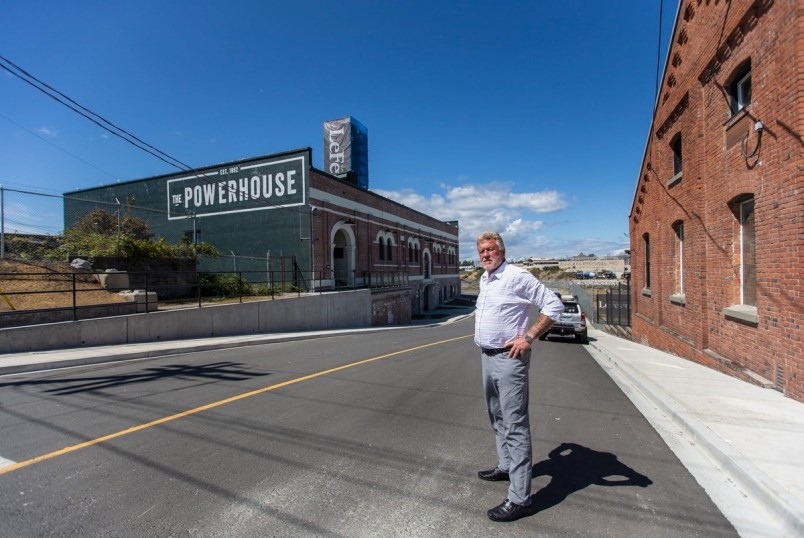Workers are repairing the old brick smokestack rising out of the 128-year-old Powerhouse building near Rock Bay in Victoria’s historic heart.
The chimney project is part of an overall upgrade of the 1892 heritage building at 2110 Store St., purchased from B.C. Hydro by developer Chris Le Fevre.
It’s one of two projects Le Fevre is working on at the northern edge of Old Town. The other is his new Ironworks development, with 85 condominiums plus commercial space at Store and Chatham streets, across from Capital Iron.
Le Fevre would not be specific, but said the cost to remediate the 20,000-square-foot building is several million dollars.
The former industrial building is now rented by Metropol Industries, which specializes in printing and marketing. Le Fevre said work on the exterior of the Powerhouse, and “cleaning the building up,” has been ongoing for nearly a year.
Le Fevre first built an access road into the property, required by the city for the Powerhouse to be subdivided from the adjacent B.C. Hydro lands.
The Powerhouse was constructed to a high industrial standard. Le Fevre calls it the most rugged heritage building he has worked with. “The reason is that it was built originally as a blast-proof building because it was generating power with generators.”
It was designed by architect and former mayor John Teague — who also designed Victoria City Hall — and is listed on the federal-provincial register of Canada’s historic places.
“The value of this building lies in its solid purpose-built form, simple Romanesque detailing, and large, open interior spaces,” says the register. “This powerhouse is an edifice in the Upper Harbour industrial area, and contributes to the diversification of Victoria’s architectural heritage.”
Built as a steam-generating plant, the Powerhouse provided power for the city’s newly electrified street lights and the city’s early trams, the register says. “It facilitated the modernization of the city as it grew in the late 19th and early 20th centuries.”
Just to the south, Le Fevre’s five-storey Ironworks development at Store and Chatham streets has been completed. It is the first phase of Ironworks, with a second stage of a similar size planned.
The former Albion Iron Works was on Chatham Street and the Capital Iron building across the street was originally a marine-scrap business.
The first residential occupants move into Ironworks in early August. The project was 60 per cent pre-sold and remaining units are going on the market in a couple of weeks, he said.
Commercial space will likely be taken up by a restaurant, coffee shops and smaller food-service outlets.
Le Fevre has redeveloped more than 10 Old Town buildings, repurposing often rundown structures for residential and commercial uses.
After 17 years, he is nearing completion on his Railyards development on the north side of the Point Ellice Bridge. Construction starts next year on the final building, featuring townhouses and micro-sized affordable units. Once that’s finished, about 400 homes will have been constructed in the Railyards.
Le Fevre is not alone in working to bring old-time Victoria into the modern age.
In May, Vancouver-based residential and commercial developer Reliance Properties bought the historic Capital Iron building and land that runs from the foreshore of Victoria’s Upper Harbour east to Government Street, including the Capital Iron parking lot and adjacent commercial buildings at 1950 Government St.
Jon Stovell, chief executive of Reliance, said the deal had been months in the making.
“We are very early in the visioning process. The site is primarily focused on employment lands and I think that will continue to be the main focus,” Stovell said, though he did not rule out a residential component.



